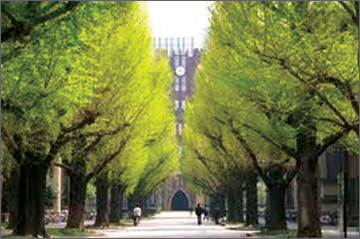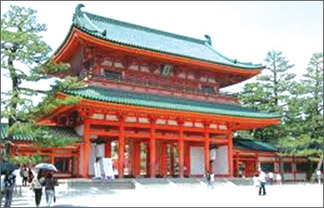Japan, the land of experience and practice
By Prof. A.J. Ruhunuhewa
 The
history of Japanese literature and education spans almost two millennia.
Shotokutaishi, a leading politician and scholar, introduced Japanese
archipelago as “The Land of the Rising Sun” (Nihon), for the first time
in the history. Linguists believe that “Japan” in English or “Japon” in
French derived from the Chinese word “Cipangu”, recorded by Marco Polo. The
history of Japanese literature and education spans almost two millennia.
Shotokutaishi, a leading politician and scholar, introduced Japanese
archipelago as “The Land of the Rising Sun” (Nihon), for the first time
in the history. Linguists believe that “Japan” in English or “Japon” in
French derived from the Chinese word “Cipangu”, recorded by Marco Polo.
The oldest literary works are known as Tennouki (“Imperial Task”) and
Teiki (“Genealogy of Emperors”). The Japanese history of literature
first began as oral traditions, and later recorded them in written form
in the early eighth century.
Accordingly, Kojiki (Record of Ancient Matters) and Nihon shoki
(Chronicles of Japan) were written, respectively, in 712 and 720, and
completed as government projects.
The former recorded ancient stories, while the second witnessed
history. The greatest literary creation of this epoch was the Man’yoshu
(Collection of Ten Thousand Leaves), a compilation of 4500 poems.
Nara and Heian periods possessed the brilliant specialists in Chinese
classics, calligraphy, engineering and architecture, and also
professionals in administration and international affairs. According to
Nihonshoki, the Japanese Mahavamsa, Prince Shotoku submitted the
Seventeen-article constitution ( Jushichijo kenpo), a rich document by
which the state was to be governed. His commentary composed on
Vimalkirti-Sutra, a teaching of the Bodhisattva concept and non-duality,
attests his profound knowledge in relevant theory and terminology.
Permission
Saicho and Kukai, the two brilliant students request the Emporer
Kammu for permission to travel abroad and were sent to China with the
diplomatic team headed by Fujiwara Kadonomaro. After a successful
completion of studies the both students returned home and Saicho, later
known as Dengyodaishi, launched the Institution of Tendai tradition of
Mahayana, at Mount Hiei.
 He
received the generous attention and support of the court and Mount Hiei
soon turned into the main Tendai Buddhist centre. His doctrine based on
the Lotus-sutra(Saddharma Pundarika)was the foundation of later schools
such as Nichiren and Sokagakkai. He
received the generous attention and support of the court and Mount Hiei
soon turned into the main Tendai Buddhist centre. His doctrine based on
the Lotus-sutra(Saddharma Pundarika)was the foundation of later schools
such as Nichiren and Sokagakkai.
Kukai, posthumously known as Kobodaishi, built the School of Arts and
Crafts and the Institute of Mount Koya, was also the founder of Shingon
tradition. He is considered as one of greatest calligraphers (Sanpitsu).
According to his study report and the covering letter titled as
“Memorial Presenting a List of Newly Imported Sutras and Other Items” (Shoraimokuroku)
Kukai introduced many Indian and Chinese classical resources to his
country. The most important work of Kukai, the “Ten Stages of
Mind”(Jujushin-ron) is another style of analysis worth to be compared
with “Ways of Thinking of Eastern Peoples” written by Hajime Nakamura,
in 1964.
Achievement
The contribution of lady writers was also a remarkable achievement in
ancient Japan and Ono no Komachi (9th century) was one of the best poets
of Heian period. She was also known as a rare beauty and became the
symbol of beauté féminine in Japan. Her literary contribution was highly
recognized among the contemporary compilers of poems and Komochi was the
only poet referred to in the introduction of Kokin Wakashu. Among other
court poets, such as Lady Ise, Ariwara no Narihara, Ki no Tomonori and
Ki no Tsurayuki are well known. The latter was a compiler of poetry and
the author of Tosa Diary. Lady Murasaki Shikibu (973-1014) was a
novelist, a poet and was also served the Imperial court.
She was also skilled in drafting administrative documents and the
author of the long fiction “The Tale of Genji” (Genji Monogatari) and
“The Diary of Lady Murasaki”. The mid of 12th century was dominated by a
military government and the literature emerged was a story of battles
such as Heike Monogatari , about the rise and fall of regional
administration. Hojoki (“The Ten Foot Square Hut”) written by Kamo no
Chomei describes the earthquakes, famine and fire at Kyoto making an
impression on impermanence (mujo). The Shakespeare of Japan, Chikamatsu
Monzaemon, who contributed immensely to the Joruri, a form of puppet
theater, developed Bunraku, and Kabuki theater. His reputation hit the
highest point with his domestic plays of love-suicides, “The Love
Suicide at Sonezaki” and “The Love Suicides at Amijima”. More than 130
plays were authenticated as authored by him.
Western model
After the Restoration of Emperor Meiji in 1868, the methods and
structures of Western model was studied and professionals with
high-ranking government officials were sent abroad. Natsume Soseki and
Mori Ogai went to England and Germany and Iwakura Mission, a well-known
diplomatic task and the vital event for the modernization of Japan to
West. In addition to the professional staff there were sixty students
accompanied and including five women.
Japan produced 19 Nobel laureates: eight in Chemistry, seven in
Physics, two in literature, one in Medicine and one in Peace. Among them
Kenzaburo Oe and Yasunari Kawabata are famous for their narrative
mastery. There are also 6 Japanese literary awards: Akutagawa Prize,
Edogawa Award, Light Novel Award, Mystery Writers of Japan Award, Noma
Prize and Mishima Award and accordingly more than128 persons were
already esteemed.
Murakami Haruki is one of world’s greatest living novelists in
postmodern literature. His novels “Kaze no uta o kike” (“Hear the Wind
Sing”) and “Noruwei no mori” (“Norwegian Wood”) achieved the highest
national and international recognition.
Nowadays three universities and fifty three schools are offering
Japanese language and literature courses, in Sri Lanka. A number of
associations is active in cultural and academic exchange with Japan,
i.e. Japanese Language Education Association (JLEASL), Japanese Language
Teachers Association (JALTAS), JICA Alumni Association (JICA-AA), Japan
Sri Lanka Technical Cultural Association (JASTECA), Japanese Graduate
Alumni Association (JAGAAS) and Lanka Japan Friendship Society (LJFS).
The Japanese are hard-workers but a few knows that the origin of the
Japanese mind and culture goes back to many centuries of experiences and
practices in sharing values, but not a sudden emergence after the Second
World War. The year 2012 is an important landmark regarding the cultural
and economic relation of Sri Lanka and Japan and accordingly celebrates
60th Anniversary of bilateral relations.
The writer holds a PhD in Asia Pacific Studies. He is the Director,
Alliance Française/ Matara and Former Senior Lecturer, University of
Paris. |

